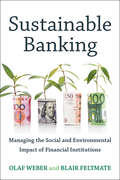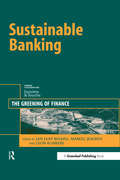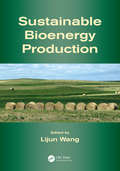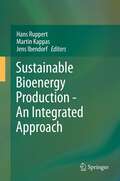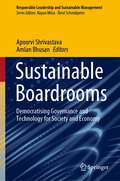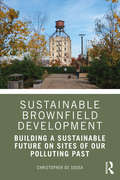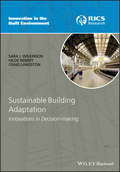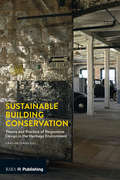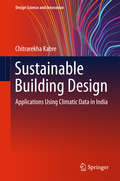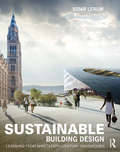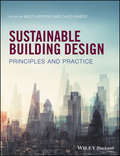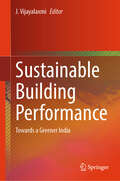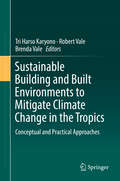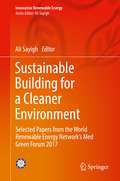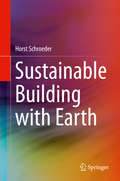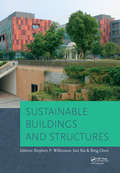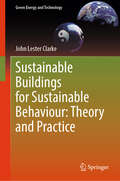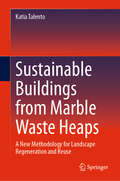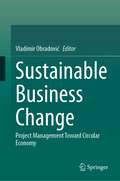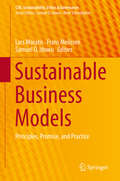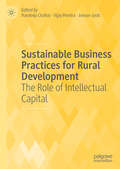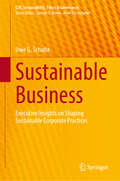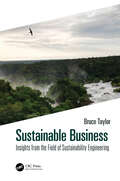- Table View
- List View
Sustainable Banking: Managing the Social and Environmental Impact of Financial Institutions
by Blair Feltmate Olaf WeberSustainable Banking introduces business leaders and students to the many ways in which financial institutions can manage their environmental and social impact and meet the needs of the current generation without compromising the needs of future generations. Olaf Weber and Blair Feltmate go beyond the business case for sustainability: how managing environmental, social, and governance risk can contribute to a bank's bottom line - to make the sustainability case for banking: how banks and other financial institutions can make a positive impact on society.In their book, Weber and Feltmate discuss the key aspects involved in making a financial institution sustainable: how to manage the direct and indirect impacts of banking activities on the community and the environment, how to minimize and mitigate the environmental footprint of internal operations, and how to account for various types of environmental and social risk in lending and project finance. They also introduce sustainable banking products and strategies being adopted by industry leaders, such as responsible investing, social finance, and impact lending.
Sustainable Banking: The Greening of Finance
by Marcel Jeucken Jan Jaap Bouma Leon KlinkersThis comprehensive addition to the debate on sustainable development has been produced in order to take a global pulse on how the financial services sector is responding to the growing challenge of shareholder and stakeholder expectations on social and environmental performance. In the opinion of many commentators in this new book, given the intermediary role banks play within economies, their potential contribution toward sustainable development is enormous. Indeed, for banks, the conclusion that corporate sustainability has become an investable concept that increases long-term shareholder value is becoming difficult to deny.To date, banks have been relatively slow to examine their exposure to risk (the environmental and social performance of their clients) and the business opportunities of sustainable development (the products and services they offer). Not before time, Sustainable Banking concludes that this is beginning to change, with both risk and opportunity becoming established elements in banking policies towards environmental sustainability. In addition, banks have now begun to take notice of and address their own environmental performance. Through the use of case studies and detailed analysis, the book examines the environmental policies of banks, the importance of transparency and communication with their stakeholders, environmental and ethical investment funds, current practice by the providers of financial services with regard to environmental risk management and, finally, the key role of government, NGOs and multilateral banks in delivering sustainability.Sustainable banking has not, however, been achieved and nor will it be in the immediate future. As globalisation proceeds apace, Sustainable Banking argues that improvements are necessary in banks' attitudes toward transparency and accountability with regard to their lending policies. In addition, in order to promote best practice, the leading banks need to start measuring their customers' environmental performance in order to persuade polluting clients that minimum compliance to regulations will no longer suffice. The book finds many shining examples in the co-operative, mutual and social sectors for the big players to emulate. Environmental and ethical considerations in such loan portfolios have proven to be profitable and "best-in-class" larger banks are now also reaping benefits.The unprecedented scope of the book has attracted contributors from four continents including Deloitte & Touche, Rabobank, The World Bank, The European Bank for Reconstruction and Development, The United Nations Environment Programme, The World Business Council for Sustainable Development, UBS, Henderson Investors, KPMG, The World Resources Institute and SAM Sustainability.
Sustainable Bioenergy Production
by Lijun WangGiven the environmental concerns and declining availability of fossil fuels, as well as the growing population worldwide, it is essential to move toward a sustainable bioenergy-based economy. However, it is also imperative to address sustainability in the bioenergy industry in order to avoid depleting necessary biomass resources. Sustainable Bioene
Sustainable Bioenergy Production - An Integrated Approach
by Martin Kappas Hans Ruppert Jens IbendorfThis book focuses primarily on the advantages and implications of sustainable bioenergy production in terms of ensuring a more sustainable world despite its growing energy demands. It addresses a new concept that focuses on the interactions between different uses of agricultural land (for example, agriculture for food, forage or energy and nature conservation) and their ecological, economic and societal impacts. This research concept provides new insights into the competition for resources and the synergies between different land uses. This book seeks to improve people's understanding of bioenergy's potentials for the future. It will be of interest not only to those involved in sustainable energy, but also to environmental planners, agriculture and soil specialists, and environmental policy-makers.
Sustainable Boardrooms: Democratising Governance and Technology for Society and Economy (Responsible Leadership and Sustainable Management)
by Apoorvi Shrivastava Amlan BhusanThis book discusses various interactions in the sustainability and development sector. It presents a thematic approach to describe progressive models and cases on disruptions, innovations, regulatory and institutional evolution related to the area of sustainability, through an organizational and boardroom level governance lens. It documents how certain schools of thought, models of engagement and methods-platforms-practices impact society and while doing so, brings together varying theoretical debates, practicing models and instruments of transformation in green governance. Sustainable policy making demands a whole of government approach in decision-making processes. Further, inclusiveness and ‘green’ consciousness of corporate boardrooms are paramount, without which, effective socially responsible business practices are absurd. Human resource development, shaped on sustainable corporate ethics, requires well-trained sustainability specialists, managers that can think ‘green’ in their overall decision making which are essential for green governance. In this context, the book creates a functional, interpretive repertoire of stories, commentaries, life experiences, and reflections of corporate leaders, academics, and practicing consultants, on their decision-making processes, and how they interpret sustainability. These stories and thoughts help create a functional academic construct, which will assist academics teach ‘green’ competencies to business school students better, and entrepreneurs and business executives to better understand the idea of sustainable growth.
Sustainable Brownfield Development: Building a Sustainable Future on Sites of our Polluting Past
by Christopher De SousaWhile industrial and chemical innovations have contributed extensively to human advancement, the darker part of their legacy has been the hundreds of thousands of polluted sites left behind. Governments at all levels have rallied to support the remediation and reuse of these land resources and put many of the nation’s brownfields back into productive use. This book presents two dozen brownfield projects in the United States that have incorporated sustainability, highlighting project features, best management practices, and lessons from the field regarding the underlying policies and practices that enabled these projects to be completed or, in some cases, stalled, altered or abandoned. The case studies represent an array of brownfield projects that aimed to go beyond conventional practice and include a range and variety of end uses (e.g., corner gas stations, industrial, office, residential, brightfields, green space, mixed-use and transit-oriented developments). The cases investigate site histories, planning and development and examine sustainability characteristics to understand how projects overcame the barriers to brownfield reuse and the implementation of sustainability features and derive a series of lessons learned, including innovative policies, programs, and/or funding mechanisms that helped make these projects work. Sustainable Brownfield Development will be of interest to developers, planners, consultants and community representatives interested in environmental policy, urban planning, community development, ecological restoration, economic development, and parks planning by providing direction and inspiration for those eager to erase the blight of the past and build a more sustainable future.
Sustainable Building Adaptation: Innovations in Decision-making (Innovation in the Built Environment)
by Sara J. Wilkinson Hilde Remøy Craig LangstonHow to adapt existing building stock is a problem being addressed by local and state governments worldwide. In most developed countries we now spend more on building adaptation than on new construction and there is an urgent need for greater knowledge and awareness of what happens to commercial buildings over time. Sustainable Building Adaptation: innovations in decision-making is a significant contribution to understanding best practice in sustainable adaptations to existing commercial buildings by offering new knowledge-based theoretical and practical insights. Models used are grounded in results of case studies conducted within three collaborative construction project team settings in Australia and the Netherlands, and exemplars are drawn from the Americas, Asia, Japan, Korea and Europe to demonstrate the application of the knowledge more broadly. Results clearly demonstrate that the new models can assist with informed decision-making in adaptation that challenges some of the prevailing solutions based on empirical approaches and which do not accommodate the sustainability dimension. The emphasis is on demonstrating how the new knowledge can be applied by practitioners to deliver professionally relevant outcomes. The book offers guidance towards a balanced approach that incorporates sustainable and optimal approaches for effective management of sustainable adaptation of existing commercial buildings.
Sustainable Building Conservation: Theory and Practice of Responsive Design in the Heritage Environment
by Oriel PrizemanThis book incorporates UK and international case studies and essays to identify the overlaps in the interests of energy and building conservation. The relevance and adjustments of qualitative and quantitative frames of reference are introduced, alongside the various expertise of the contributors: architects, designers, conservation consultants and academics. The second part of the book showcases sustainable domestic and non-domestic heritage projects, translating the preceding research into information that practitioners can use in their everyday work. The book will appeal to architecture students, newly qualified professionals and conservation architects and will enhance readers’ ambitions, so that they feel equipped and inspired to work with old buildings sensitively, creatively and sustainably.
Sustainable Building Design
by Chitrarekha KabreThis book bridges the gap between research and practice in the area of sustainable design of buildings, exploring the passive (climate-responsive) design and thermal behavior of buildings and ways to incorporate these enhancements in architectural and civil engineering practice. It presents climatic data and its analysis in a readily usable form and shows ways in which such data can be used to achieve passive (climate-responsive) and sustainable building design. The book presents case studies of sustainable building in each of five climatic zones of India. The book includes climatic data from 62 cities in India and describes how it can be synthesized in sustainable building design. The book can serve as a practical tool or handbook for architects, engineers, and designers, providing them with an understanding of the physical phenomena involved and a means for suitably implementing and applying passive (climate-responsive) design principles. It also offers a valuable resource for researchers, students, and policymakers working in the area of sustainable building design and construction.
Sustainable Building Design: Learning from nineteenth-century innovations
by Vidar LerumA twenty-first century renaissance is emerging in architecture. After a century of building designs characterized by high energy demand, low quality lighting and poor thermal comfort, the fundamental questions must be asked again: is there a better path to designing the most energy efficient, comfortable, functional and beautiful buildings for a sustainable future? While seeking solutions for the future, are there lessons to be learned from the best buildings of the past? Sustainable Building Design explores outstanding buildings and building designs of the twenty-first century, with an emphasis on the artistry of masters of architecture who came before. By dissecting and analyzing great public buildings of the nineteenth and twenty-first centuries, materials, techniques, and methods are discovered. This book presents the reader with clues and suggestions that will reveal the secrets of these buildings and by doing so provides the reader with a thorough understanding of how these architectural masterpieces work. Using photographs, drawings, sections, plans and diagrams which are painstakingly redrawn for consistency and clarity based on a wide range of documentation, Vidar Lerum compares works of architecture from the nineteenth and twenty-first centuries. The reader is presented with a careful analysis of each building, providing a compelling sourcebook of ideas for students and professional architects alike.
Sustainable Building Design: Principles and Practice
by Miles Keeping David ShiersAn inside view of how one of the world's leading architecture and engineering practice does business Sustainable Built Environments: Principles and Practice offers detailed, environmentally sound design solutions to a wide range of building engineering challenges. The text uses case examples and project data provided by engineers and designers at Arup Associates. It covers a broad range of relevant issues, with focused commentaries and explanations presented in an accessible format for use by students, busy practitioners and informed clients. Whilst this book stresses the importance of a unified approach to design, the text is divided into six principal chapters, each addressing an important aspect of sustainable architecture and engineering. These chapters (Master Planning, Transport, Energy, The Building Envelope, Environmental Services, and Materials) may be read on their own or in sequence as part of a narrative. Throughout the book, photographs, architectural and engineering drawings and diagrams, examples, and other data illustrate the case studies. Numerous web links are provided to additional information. This inspirational book: Focuses on the work of Arup Associates, the award winning architectural and engineering practice Uses real-life examples of functioning buildings and structures to provide information and guidance on the development of sustainable solutions Is packed with informative illustrations Sustainable Built Environments: Principles and Practice is a unique text that will inform and inspire architects and engineers, as well as students of those disciplines, around the globe.
Sustainable Building Performance: Towards a Greener India
by J. VijayalaxmiThis book highlights the evaluation and assessment of various aspects of sustainable buildings to achieve a greener future. India, at the 26th session of the United Nations Framework Convention on Climate Change (COP 26) in November 2021, announced its target to achieve net zero by 2070. Being an emerging economy, the number of buildings required is expected to grow exponentially. Hence, there is a need for a pragmatic and realistic path to reach the committed goal of reaching net zero. To participate in a global transition to clean, low-carbon energy systems, which aligns with Sustainable Development Goal (SDG) 11 (Sustainable Cities and Communities) and Climate Action (SDG 13), it is important to research cooling strategies for a tropical country like India. The India Cooling Action Plan clearly acknowledges the deep connection between SDGs, especially SDG 13. Passive cooling strategies require a micro-level understanding of the impact of building materials on the thermal performance of buildings. To contribute to the global transition to clean, low-carbon energy systems, it is essential to assess India's energy retrofit policies, the use of low-carbon building materials, energy-efficient building design to enhance passive cooling, ways to mitigate outdoor heat, and learnings from vernacular architecture and biophilic building design. This book explores how viable solutions such as these could address some of India's most pressing challenges, including energy efficiency, climate resilience, and environmental sustainability, contributing to India's progress towards SDG 3 (Good Health and Well-being), SDG 7 (Affordable and Clean Energy), SDG 9 (Industry, Innovation, and Infrastructure), and SDG 13. The research papers presented in this book are the result of systematic research conducted after identifying a research gap through the latest review of literature. They present new knowledge that can aid in making performance-based design decisions. All these aspects are analyzed using real-time data obtained through field studies. The book is a valuable resource for professionals and researchers working in energy efficiency and sustainable buildings.
Sustainable Building and Built Environments to Mitigate Climate Change in the Tropics
by Tri Harso Karyono Robert Vale Brenda ValeThis book offers a selection of the best papers presented during the International conference on Mitigating and Adapting Built Environments for Climate Change in the Tropics, held at Tanri Abeng University (TAU), Jakarta, Indonesia, March 2015. The book is divided into four main parts. The first part deals with the general issue of climate change, the cause and the ways to mitigate and to adapt the built environment for climate change in a number of countries. Part 2 deals with the conceptual ways to mitigate building for climate change. The ways to reduce cooling energy in tropical buildings by means of passive design. Part 3 offers papers that examine the way to overcome disasters in the city caused by climate change. The final part deals with the role of plants in mitigating and adapting built environments to climate change - the use of plants, trees and bushes to directly and indirectly reduce carbon emissions are discussed.
Sustainable Building for a Cleaner Environment: Selected Papers from the World Renewable Energy Network's Med Green Forum 2017 (Innovative Renewable Energy)
by Ali SayighThis book contains selected papers presented during the bi-annual World Renewable Energy Network’s Med Green Forum aimed at the international community as well as Mediterranean countries. This forum highlights the importance of growing renewable energy applications in two main sectors: Electricity Generation and the Sustainable Building Sector. In-depth chapters highlight the most current research and technological breakthroughs, covering a broad range of renewable energy technologies and applications in all sectors – for electricity production, heating and cooling, agricultural applications, water desalination, industrial applications and for the transport sectors.
Sustainable Building with Earth
by Horst SchroederThis book provides an insightful overview of the current state of earth building. The author approaches the subject from the perspective of the building material's life cycle, featuring in-depth explanations of the cycle's individual steps: extraction and classification of construction soil; production of earth building materials and earthen structures; planning, construction and renovation of earth buildings; and demolition and recycling of earthen structures. This unique resource provides examples of sophisticated earth building projects and illustrates the diverse applications of earth as a building material. Compared to conventional mineral building materials, earth possesses particularly positive ecological qualities such as its energy balance and recyclability. Architects, engineers, students, manufacturers and distributors of building materials, building contractors, building biologists, public authorities and preservationists will benefit from this book's ample coverage of restoring, optimizing and building with this material of the past, present and future.
Sustainable Buildings and Structures: Proceedings of the 1st International Conference on Sustainable Buildings and Structures (Suzhou, P.R. China, 29 October - 1 November 2015)
by Bing Chen Jun Xia Stephen P. WilkinsonSustainable Buildings and Structures collects the contributions presented at the 1st International Conference on Sustainable Buildings and Structures (Suzhou, China, 29 October-1 November 2016). The book aims to share thoughts and ideas on sustainable approaches to urban planning, engineering design and construction. The topics discussed include:-
Sustainable Buildings for Sustainable Behaviour: Theory and Practice (Green Energy and Technology)
by John Lester ClarkeThis book is about where theory meets practice in the realm of sustainable architecture. The book reveals how to create buildings that not only minimize environmental impact but also help shape sustainable behaviour. Including a literature review, comprehensive online surveys, and analysis of real projects, the book presents a narrative that blends theory with tangible examples. It includes illustrated case studies that breathe life into five exemplary sustainable buildings, showcasing their impact. The book demonstrates the potential of architecture to realise a sustainable future. It shows how construction can help build a more sustainable world.
Sustainable Buildings from Marble Waste Heaps: A New Methodology for Landscape Regeneration and Reuse
by Katia TalentoThis book examines how discarded marble heaps can be repurposed, in situ, to breathe new life into the landscape, offering solutions that are as innovative as they are practical and sustainable. The author showcases the power of creativity and sustainability to revitalize communities and landscapes with new architectural buildings and public spaces. The volume combines theory with practice, including an extensive bibliography about landscape mutation, rehabilitation of quarries and waste reuse, and, at the same time, a detailed case study on the Estremoz Anticline, in Portugal, one of the world’s main sites of marble extraction. Of all the material extracted from the several quarries of the Estremoz Anticline, only about 9% is marketed because of assessed of quality standards. Distinct from other research volumes in this domain, “Sustainable Buildings from Marble Waste Heaps” focuses on the regeneration of industrial landscapes through the on-site reuse of waste heaps, without removing the material from the context it belongs to or changing its morphology, preserving the identity of the place and promoting circular economy.
Sustainable Business Change: Project Management Toward Circular Economy
by Vladimir ObradovićThis volume aims to explore project management contributions to sustainable business change based on renewability, reuse, and repair as well as the effect of circular economy business solutions on project management in terms of the management approach, governance, and leadership. The main aim of integrating project management with a circular business paradigm is not only to learn how project management can contribute to achieving circular economy principles, but also to understand the impact of business needs on project management. By understanding these needs, recommendations can be developed and promoted among different stakeholders such as governments, financial institutions, and education institutions with the goal of supporting and assisting project management to drive sustainable business change. This approach will enable readers to assess how project management professions can support a shift toward sustainable business. The primary audience of this work is management scholars, educators, researchers, and students. Scholars, government representatives, financial institutions, management educators, start-up companies, innovative entrepreneurs, and all others who use the circular economy to support sustainable development can also find much of use in this book.
Sustainable Business Models: Principles, Promise, and Practice (CSR, Sustainability, Ethics & Governance)
by Samuel O. Idowu Frans Melissen Lars MoratisThis book provides a rich overview and takes a closer look at the current state of theory and practice in the field of sustainable business models. The chapters in this book examine and analyze existing and new approaches towards sustainable business models and showcase the implementation of sustainable business through both quantitative and qualitative studies, including several case studies and many practical examples. It approaches these issues from the standpoints of diverse business disciplines to yield new insights and ideas that are relevant from both an academic and professional perspective. In its essence, the book examines how firms’ value creation processes can be driven by sustainability and social responsibility and how this impacts business and society. Readers will find a range of sustainable business models that have been employed and are being pioneered in various industries around the globe – which are thoroughly investigated and discussed, and put into a comprehensive conceptual framework.
Sustainable Business Practices for Rural Development: The Role of Intellectual Capital
by Vijay Pereira Hardeep Chahal Jeevan JyotiThe book includes empirical research papers and case studies embracing human capital, relational capital and structural capital in context to services and manufacturing sectors. It will highlight on the sustainable business practices manifested in the work culture, values and beliefs in context to rural regions. From a learning and managerial perspective, the book will identify effective business practices in varied service and manufacturing sectors significant for sustaining business performance and competitive advantage.
Sustainable Business in the Era of Digital Transformation: Strategic and Entrepreneurial Perspectives (ISSN)
by Vesna Zabkar Marek Ćwiklicki Mariusz Sołtysik Magdalena Wojnarowska Maria Urbaniec Erica VareseSustainable development is a complex issue and despite many studies and publications in recent years, it remains poorly recognised on best practices in core business areas. Achieving the Sustainable Development Goals in accordance with the 2030 Agenda for Sustainable Development depends on research and innovation. Therefore, the transition to sustainable development requires investment in technology, new business models, and social and environmental innovations that contribute to shaping new business and promoting sustainable business practices.This book seeks to understand how sustainability affects core business areas, with a focus on strategic and entrepreneurial activities. Given these considerations, the main purpose of this book is twofold: (1) to contribute to a better understanding of important and current trends in the field of sustainable transformation in core business areas; and (2) to provide a comprehensive overview of quantitative and qualitative studies in the field. The book ultimately seeks to shed light on how companies are implementing sustainable transformation in the core areas of product and marketing, entrepreneurship, and innovation, which is supported by appropriate project management strategies.The book provides researchers and upper-level students in economics, business, and other social sciences with an overview of interdisciplinary theoretical and conceptual perspectives and frameworks for successful business transformation. It will be of particular value to those researching sustainable development and strategic management.
Sustainable Business: Executive Insights on Shaping Sustainable Corporate Practices (CSR, Sustainability, Ethics & Governance)
by Uwe G. SchulteThis book presents discussions with corporate practitioners on several topics around sustainability. Between May 2019 and November 2022, the author engaged in dialogues with Senior Executives representing major multinational corporations, overseeing their corporate sustainability endeavours. The thematic spectrum of these conversations encompassed diverse topics such as The United Nations Sustainable Development Goals, Water-stressed regions, Ocean Plastic, Chemical Recycling, Renewable Energy, Sustainable Tourism, and the Just Transition, among others, with each episode concentrating on a singular subject. In this book supporting illustrations and graphs together with background references enrich the insights the conversations convey. The reader will learn about the sustainability challenges companies are facing and how they approach them. The book gives examples of sustainable solutions and international collaborations around greenhouse gas reduction, circular economy, restorative tourism as well as reducing plastic pollution and other global sustainability challenges.
Sustainable Business: Insights from the Field of Sustainability Engineering
by Bruce TaylorEngineers have applied science to land people on the moon, design the cars we drive, and cram the power of a 20th-century supercomputer into the phones we carry. But what can happen when engineering’s systemic problem-solving skills are applied to improving the sustainability of business?This book stands on the shoulders of sustainability engineering insights to supplement business, engineering, and environmental curricula with tools necessary to effectively and efficiently improve the sustainability of organizations. Cutting through the clutter of terminology and approaches, this book uses case studies to outline a proven path to profitably secure “net zero” for facilities and their supply chains. And rather than stopping at the uninspiring target of “doing no harm,” it further empowers businesses and other organizations to create additional economic, environmental, and social benefits.This book: Offers numerous case studies from the Space Shuttle through the world’s first carbon neutral major food company to appropriate technology for safe water in developing countries to illustrate how to reduce environmental footprints while increasing profit margin and business value Explores redemptive entrepreneurship through the lens of the author’s founding of an award-winning engineering firm Presents strategies to strengthen the curricula of engineering, business, accounting, and procurement programs by uncovering significant sources of untapped value in conventional teaching
Sustainable Business: Key Issues
by John Blewitt Helen KopninaSustainable Business: Key Issues is the first comprehensive introductory-level textbook to address the interface between environmental challenges and business solutions to provide an overview of the basic concepts of sustainability, sustainable business, and business ethics. The book introduces students to the background and key issues of sustainability and suggests ways in which these concepts can be applied in business practice. Though the book takes a business perspective, it is interdisciplinary in its nature and draws on knowledge from socio-economic, political, and environmental studies, thereby providing a practical and critical understanding of sustainability in the changing paradigm of global business. It goes beyond the conventional theories of sustainability and addresses critical issues concerned with population, consumption and economic growth. It discusses realistic ways forward, in particular the Circular Economy and Cradle to Cradle frameworks. The book is both a theoretical and practical study guide for undergraduate and postgraduate international students of broad areas of sustainability, teaching ways to recognize opportunities for innovation and entrepreneurship at the intersection of environmental, economic, ethical, and social systems. It takes a strategic approach in applying the power of business methods and policy to address issues of global importance such as climate change, poverty, ecosystem degradation and human rights. This textbook is essential reading for students of business, management and sustainability courses. It is written in an engaging and accessible style, with each chapter including case studies, discussion questions, end of chapter summaries and suggestions for further reading.
